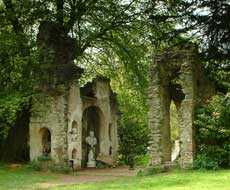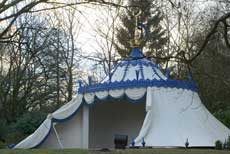Charles Hamilton did not possess a large fortune to fund his ambitious designs.
Most of the garden buildings at Painshill were flimsily built, many made of wood rendered to look like stone.
‘The whole thing was a stage set, really,' comments Mike Gove , who took over as chief executive of the Trust in 2002.
In many cases, few of the original materials remained. ‘After the war there was a shortage of building materials, so as the site wasn't secure, people used to come in and take things away,' explains Mike.
Archaeologists had found the brick foundations of many features, such as bothies and pine pits in the walled garden, but all loose materials had been spirited away from the site.
At the outset, Janie Burford and her team aimed to restore Hamilton's buildings as closely as possible to the original. For example, they rebuilt the Gothic Temple using lath and plaster, as it had been in Hamilton's time, although there were some concessions to modernity in the form of a new steel roof with drainage system, which had not been there originally.
Despite these improvements, the Temple has needed major ongoing maintenance to keep it in pristine form, and as a result the original purist restoration philosophy has been tempered by a more pragmatic approach. Durability and cost-effectiveness have become more important.
‘When the restoration of the Gothic Temple was undertaken, the architect wanted to be so pure that he didn't even want to use treated timber. I wouldn't build it that way now,'
Besides the longevity of his buildings, another aspect that Charles Hamilton would never have had to take into account was the effect of the paying public on his landscape and its features. The Turkish Tent was originally restored with painted canvas drapes, as they had been in Hamilton's time, but after a season or two of being fingered by visitors the drapes looked terrible, and a decision was made to use fibreglass instead.

Photograph of the re-created
Turkish Tent, Painshill Park,
December 2004. Copyright:
Painshill Park Trust.
'English Heritage accepts that modern materials can be used in appropriate situations.'
In 2008, there are still a number of Hamilton's original buildings still to be restored or recreated: the Temple of Bacchus, the five-arch bridge, the roof of the Mausoleum and the side walls on the Ruined Abbey.
The bridge and the Temple, originally constructed of lath and plaster on brick foundations, will be rebuilt in masonry, says Mike. He estimates the cost of rebuilding the Temple at around £600,000, but considers that this would be the most cost-effective solution in the long term.
‘Hamilton did it in a render to look like stone because he couldn't afford the stone,' explains Mike. ‘For maintenance and longevity I'd sooner restore it in more robust materials, which Hamilton would have done if he could have afforded it.'

The Mausoleum after
restoration. Photograph by
Carmen Evans, April 2004.
Copyright Painshill Park Trust.
